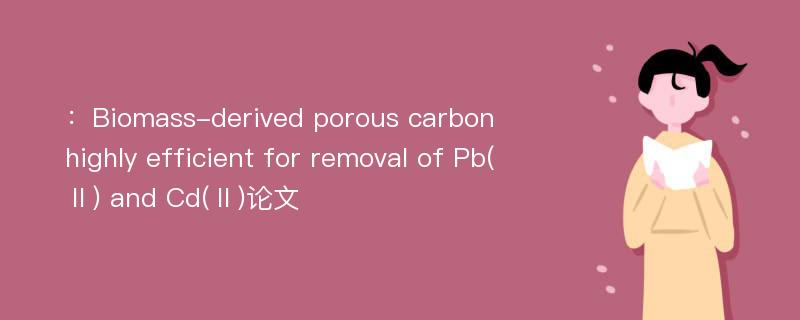
本文主要研究内容
作者(2019)在《Biomass-derived porous carbon highly efficient for removal of Pb(Ⅱ) and Cd(Ⅱ)》一文中研究指出:The utilization of abundant and renewable biomass to fabricate advanced functional materials is considered a promising route for environmental applications. Herein, Lignin-based porous carbon with layered graphene-like structure(LPC) is successfully synthesized and applied to efficiently remove Pb(Ⅱ) and Cd(Ⅱ). The as-synthesized LPC materials are systematically characterized and these results show that LPC has a porous graphene-like structure, facilitating the diffusion and immobilization of heavy metal ions. The influence of different reaction parameters(solution pH, initial concentration of metal ions, contact time and adsorbent amount) on the adsorption performance is investigated in details.The results demonstrate that LPC can achieve superior adsorption capacities of 250.5 mg g-1 for Pb(Ⅱ) and 126.4 mg g-1 for Cd(Ⅱ), which are far superior to the previously reported adsorbents. Pseudo-second order kinetics model and Freundlich isotherm model describe the adsorption process well. Furthermore, the exhausted LPC can be regenerated easily and exhibits the removal efficiency of 96% and 92% for Pb(Ⅱ) and Cd(Ⅱ) after five continuous runs, respectively. This study shows a sustainable strategy for the design of porous carbon material from na?ve biomass and highlights the great potential in wastewater treatment.
Abstract
The utilization of abundant and renewable biomass to fabricate advanced functional materials is considered a promising route for environmental applications. Herein, Lignin-based porous carbon with layered graphene-like structure(LPC) is successfully synthesized and applied to efficiently remove Pb(Ⅱ) and Cd(Ⅱ). The as-synthesized LPC materials are systematically characterized and these results show that LPC has a porous graphene-like structure, facilitating the diffusion and immobilization of heavy metal ions. The influence of different reaction parameters(solution pH, initial concentration of metal ions, contact time and adsorbent amount) on the adsorption performance is investigated in details.The results demonstrate that LPC can achieve superior adsorption capacities of 250.5 mg g-1 for Pb(Ⅱ) and 126.4 mg g-1 for Cd(Ⅱ), which are far superior to the previously reported adsorbents. Pseudo-second order kinetics model and Freundlich isotherm model describe the adsorption process well. Furthermore, the exhausted LPC can be regenerated easily and exhibits the removal efficiency of 96% and 92% for Pb(Ⅱ) and Cd(Ⅱ) after five continuous runs, respectively. This study shows a sustainable strategy for the design of porous carbon material from na?ve biomass and highlights the great potential in wastewater treatment.
论文参考文献
论文详细介绍
论文作者分别是来自Green Energy & Environment的,发表于刊物Green Energy & Environment2019年04期论文,是一篇关于,Green Energy & Environment2019年04期论文的文章。本文可供学术参考使用,各位学者可以免费参考阅读下载,文章观点不代表本站观点,资料来自Green Energy & Environment2019年04期论文网站,若本站收录的文献无意侵犯了您的著作版权,请联系我们删除。
